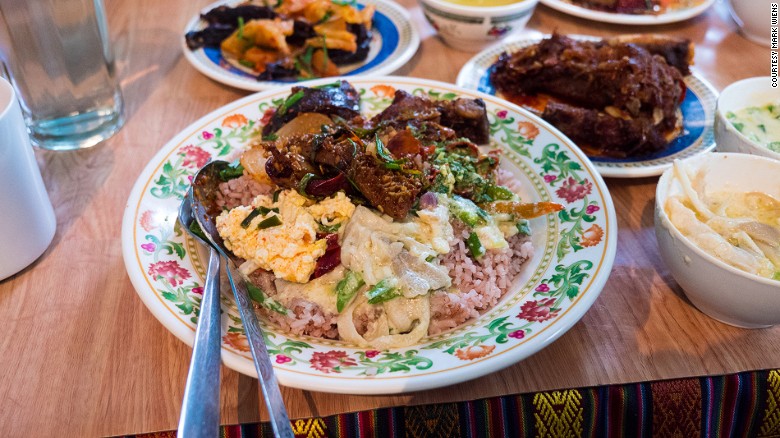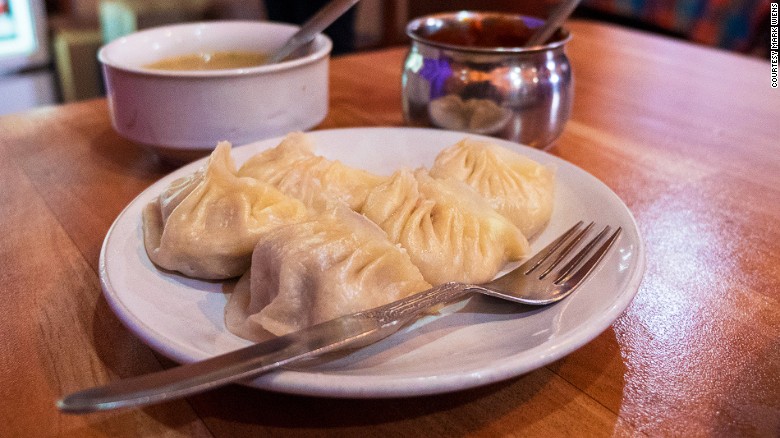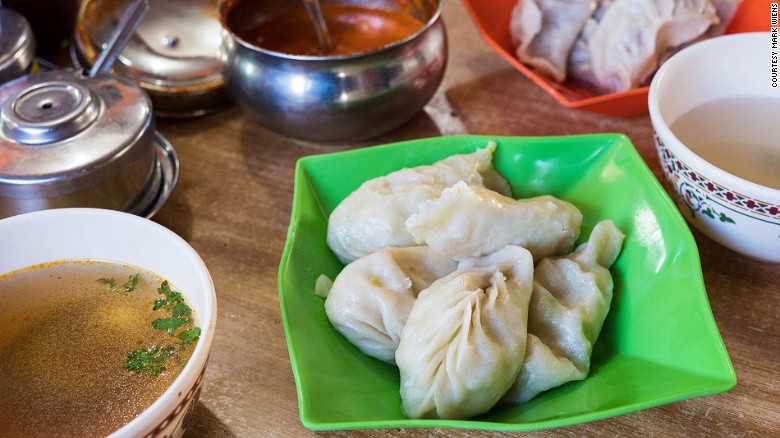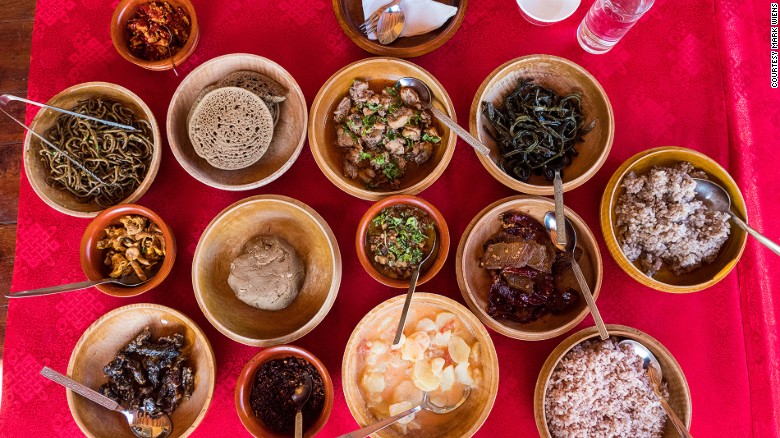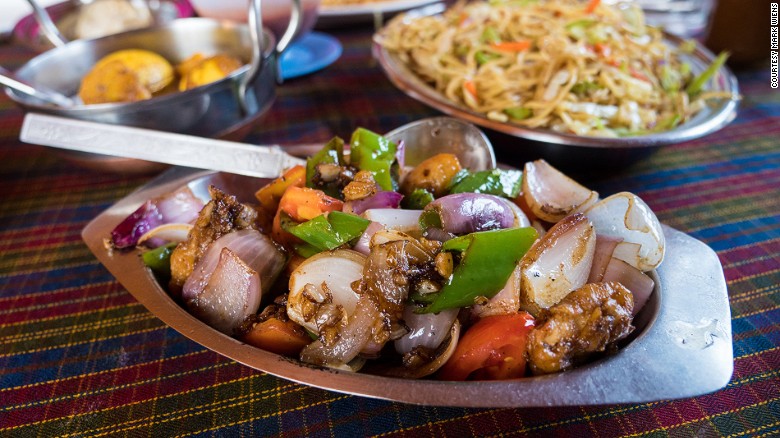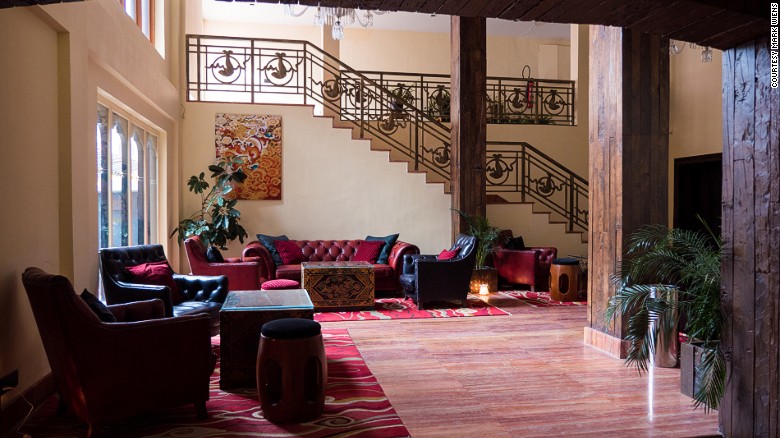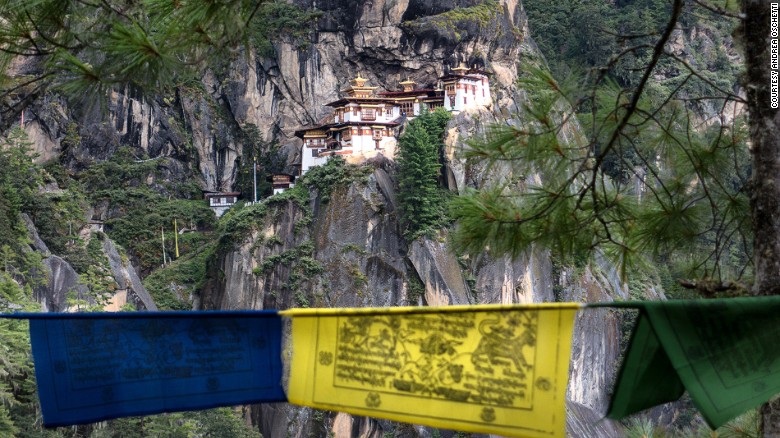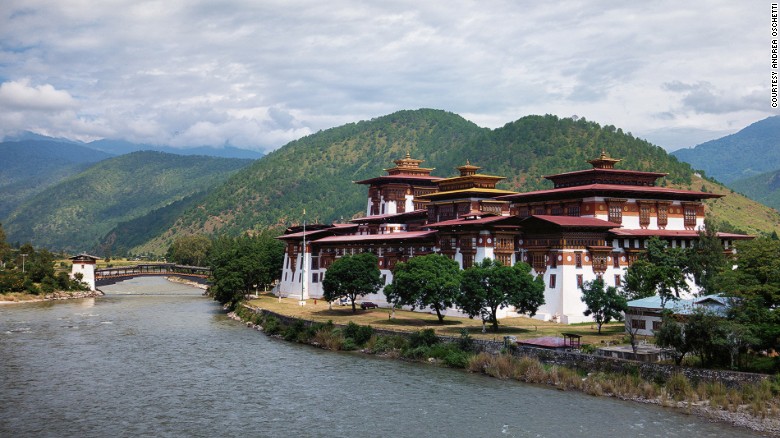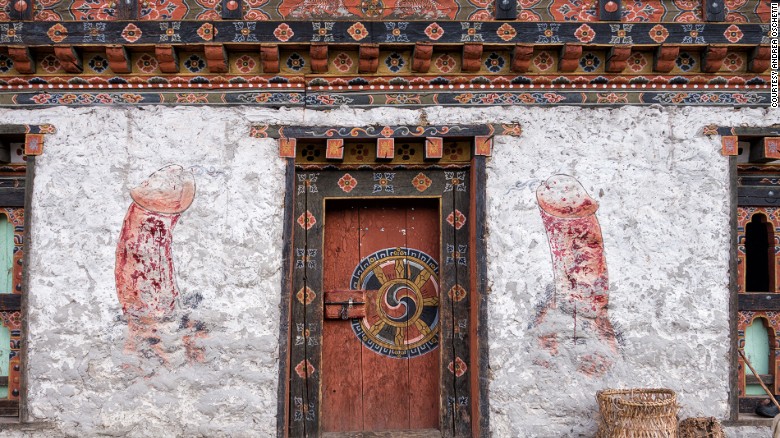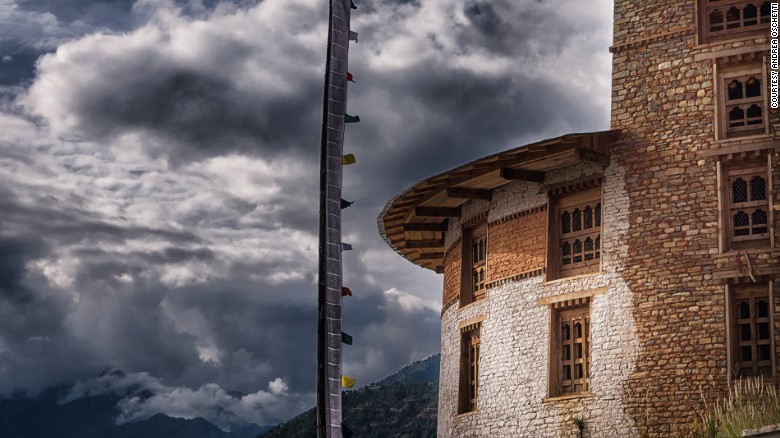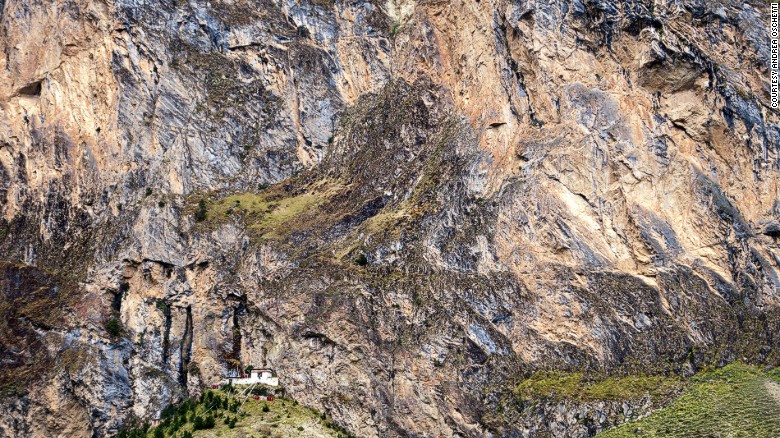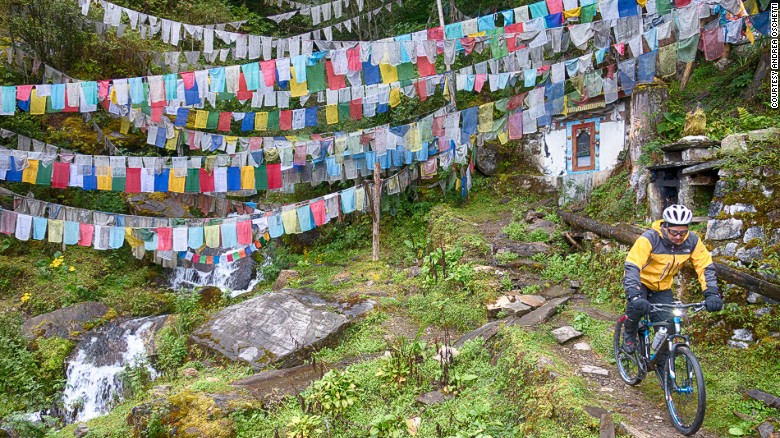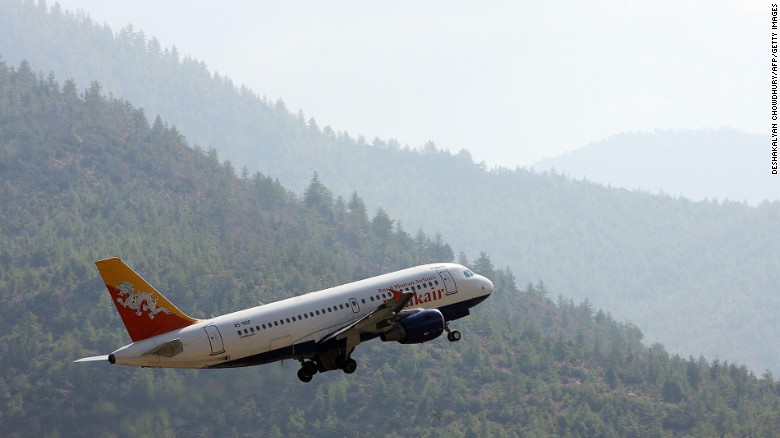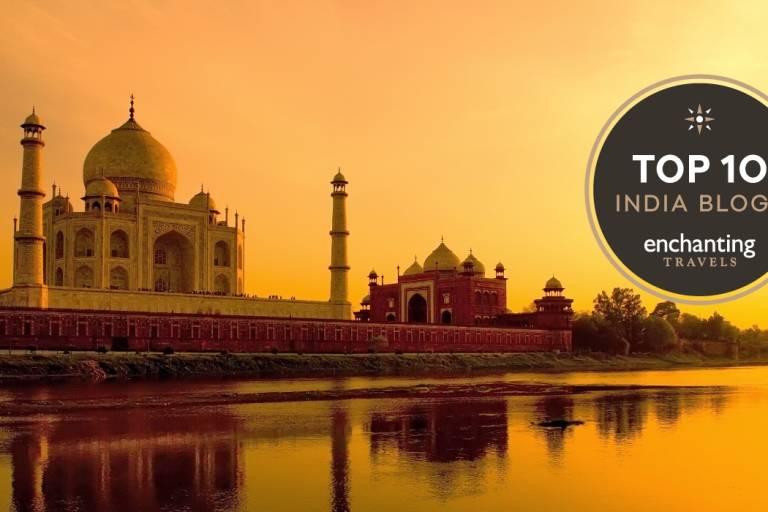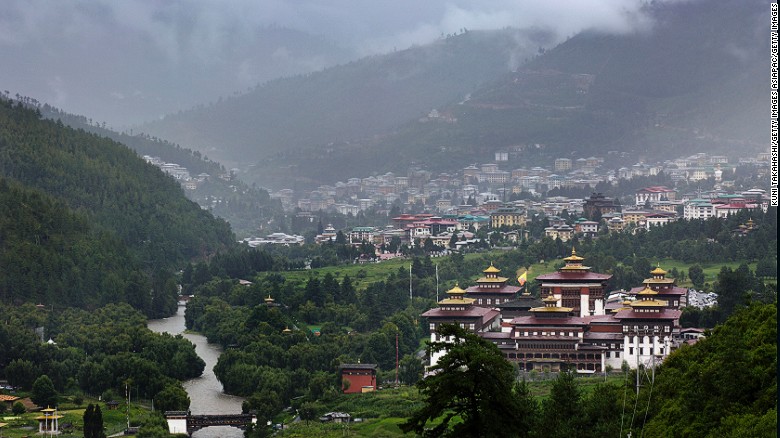
In the age when not even a secretive communist state is spared from the Internet, Bhutan remains one of the most mysterious lands in the world.
The world largely knows the majority Buddhist country for its stunning, cliff-side Taktshang Lhakhang temple and unique Gross National Happiness index.
“Economists the world over have argued that the key to happiness is obtaining and enjoying material development,” says the Tourism Council of Bhutan. “Bhutan, however, adheres to a very different belief and advocates that amassing material wealth does not necessarily lead to happiness.
“Bhutan is now trying to measure progress not by the popular idea of Gross Domestic Product but by through Gross National Happiness.”
Beyond these famous facts, few outsiders can tell you much about the country.
Can you name the capital city?
It’s Thimphu (population 100,000), the economic, religious and government center of the country, residence of the Royal family and, according to the Bhutanese government, the only capital city in the world with no traffic lights.
It’s served by Paro Airport, the only international airport in the country.
The Himalayan kingdom (population 750,000) has largely been able to safeguard its distinct traditions — its beliefs, language and royal family — with a unique and stringent visitor policy (see “Entry” section below) overseen by the Tourism Council of Bhutan.
But there’s an incredible amount of scenery and culture spread across every corner of the 38,000-kilometer-square country (just smaller than Switzerland, just larger than Taiwan).
Here’s how to see all of this spectacular ancient land with a very forward minded take on tourism.
Le Méridien Thimphu
Entry
Bhutan officially targets “high value, low impact” tourism.
“The Royal Government of Bhutan recognizes that tourism is a worldwide phenomenon and an important means of achieving socioeconomic development particularly for a developing country like Bhutan,” reads the country’s national Tourism Policy.
“Toward achieving this objective, the Royal Government, has adopted a very cautious approach to growth and development of the tourism industry in Bhutan.”
This means the first step in planning any trip to Bhutan is to visit the Tourism Council of Bhutanwebsite for a list of regulations required of all visitors and a breakdown of the important Minimum Daily Package fees.
The fees include all accommodations, daily meals, transportation, services of licensed guides and porters and cultural programs where and when available, according to the Tourism Council.
The 2016 daily tariff is $200 per person, per night for the months of January, February, June, July, August and December; and $250 per person, per night for the months of March, April, May, September, October and November.
However, the rate can fluctuate and visitors should check with the Tourism Council of Bhutan when planning a trip.
Most visitors are required to arrange a tour through a designated agency in order to begin the application for a tourist visa.
While many tour companies offer similar standard packaged tours, others, such as My Bhutan andBhutan Musk Travels, customize unique itineraries to satisfy personal requests.
Restaurants
Kalden Restaurant
Locally famous in Thimphu, Kalden is an ultimate no-frills Bhutanese restaurant.
The menu includes pretty much all the standard Bhutanese dishes — ema datshi (cheese and chiles), shamu datshi (mushrooms and chiles), sikam paa (dried pork belly with dry chiles), shakam paa (dried beef and dry chiles) and cheese egg fry.
All of these are eaten with Himalayan red rice.
Dishes are exceedingly flavorful, heavy on cheese, butter and, in case you weren’t paying attention, chiles.
For a true local food experience, Kalden is not to be missed.
Kalden Restaurant, Chang Lam Road, Thimphu; open for lunch and dinner daily; +975 1766 7576
Zombala
Although momos (dumplings) are technically Tibetan, they’re a big favorite in Bhutan, easily the most common fast food meal or snack.
The momo wrapper is like a thick noodle. It’s stuffed with filling, wrapped like a dumpling, then steamed.
Among Thimphu’s longest standing momo restaurants is Zombala, a laid back, family-run establishment that serves steaming hot plates of momos.
Varieties include minced beef and vegetarian, which include cheese and cabbage.
The house-made chili sauce, fragrant with dried chiles and garlic, is the preferred momo condiment.
Bhutan Kitchen
Occupying the second floor of a building in the heart of Thimphu, Bhutan Kitchen is a quiet, family-style Bhutanese restaurant.
It’s spacious and laid back, with low tables and benches wrapped in wool blankets.
On arrival, visitors are offered home-brewed ara, a Bhutanese alcohol, which is served in small wooden bowls.
The dishes are also served in traditional wooden bowls, and you can eat with provided utensils or with your fingers.
The kewa datshi (cheese with potatoes) has a wonderful smoky cheese flavor.
The Jasha tshoem (chicken curry) has an unforgettable, ginger-infused flavor.
Wangchen Momo Corner
Mention momos to anyone from Thimphu, and the first restaurant they’ll likely mention will be Momo Corner, possibly the city’s most popular restaurant.
Always bustling, it serves both vegetarian and beef momos, plus a short menu of Tibetan-influenced dishes like thukpa (noodle soup) and fried noodles.
The restaurant is located on the corner of the weekend Centenary Farmers Market, making it a good place to stop in the middle of exploring the market.
Wangchen Momo Corner, Sabji Bazaar, Thimphu; open Wednesday-Monday for lunch and dinner; +975 1760 4617
Folk Heritage Museum Restaurant
For an authentic meal including some hard-to-find traditional Bhutanese dishes, the Folk Heritage Museum Restaurant is the spot.
The owner has a passion for preserving and promoting Bhutanese cuisine.
She strives to help customers, tourists and locals understand the ingredients and history that go into traditional cooking.
Must-eat dishes include dried beef sauteed in yak cheese, buckwheat noodles, barley dough, a number of unique chili sauces and an herbal butter tea.
Sonam Trophel
Opened in 1986, which makes it one of Paro’s oldest restaurants, Sonam Trophel serves an extensive selection of Bhutanese, Tibetan and Indian dishes.
Along with Bhutanese favorites like ema datshi (cheese and chiles) and shakam paa (dry beef and dry chiles), the boneless chili chicken (fried nuggets of crispy chicken with fresh chiles and onions in sweet and sour sauce) is superb.
The restaurant is also famous for pork momos, which aren’t common in Bhutan but which are delicious.
The dish includes a ball of minced pork and a spoon of pork broth steamed inside each wrapper.
Nightlife
Mojo Park
Visitors don’t typically come to Bhutan for the raging nightlife.
But there are a few spots to check out after dark.
Mojo Park is one of Thimphu’s most popular nighttime hangouts.
A neighborhood-style pub and live music venue, the atmosphere is similar to a blues pub in any major capital city around the world.
Start mingling, though, and the overwhelming friendliness and positive energy will remind you that you’re still in Bhutan.
Space 34 Nightclub
All-out partying in Thimphu?
The closest thing is at Space 34, which offers the liveliest party in the city on three nights a week.
Thumping electro beats keep a stylish crowd dancing well into the night.
Space 34 Nightclub, Chang Lam, Thimphu; 9 p.m.-1 a.m., Wednesday, Friday, Saturday; +975 1755 4945
Hotel Druk
Opened in 1985, Hotel Druk is one of Thimphu’s “classic” hotels.
It’s still very well maintained.
The bar is reminiscent of a European pub. It’s decorated with pieces of vintage wood from around Bhutan.
The menu is international but the selection of Bhutan whiskeys is worth a try.
Attractions
Taktsang Lhakhang
Perched on a sheer rock cliff 3,120 meters (10,236 feet) above sea level in the Paro Valley, the Taktsang Lhakhang Buddhist temple complex is Bhutan’s most famous attraction for tourists, locals and religious pilgrims.
Known as the Tiger’s Nest, its primary access is a well marked but demanding path that climbs through a forest of oak and rhododendron.
The occasional clearings among the trees present breathtaking vistas of the monastery and offer visitors the opportunity to catch their breath.
It’s a special place: many Tibetan saints, including Milarepa, came to meditate here.
Today’s travelers appreciate its intense spirituality, and the physical effort required to reach it.
The complex consists of four main temples and several smaller buildings, all interconnected by staircases with steps carved into the rock.
Balconies from each building provide spectacular views of the surrounding countryside.
Interiors are luxurious.
The Hall of Thousand Buddhas houses a large statue of a tiger. According to legend, the location of the monastery was chosen by a tigress.
Punakha Dzong
Strategically settled at the confluence of the Mo and Pho rivers to protect Bhutan from Tibetan invasions, Punakha Dzong is the country’s greatest fortress.
It hosts the most sacred of Bhutan’s possession: an image of the Bodhisattva of Compassion that Guru Rinpoche brought with him to Bhutan from Tibet.
In 1639, a Tibetan military force attempted to take the relic back, but were repelled.
The historic episode is reenacted annually in winter, with a popular procession.
Accessed by a cantilever bridge, the Dzong comprises of 21 temples.
The architecture, murals and statues are considered the finest examples of Bhutanese art.
Chimi Lhakhang
Drukpa Kunley is the Divine Madman.
A heroic figure of the Buddhist path to enlightenment, he’s defined by spiritual accomplishments rather than servile observance of strict monastic protocols.
He belongs to the tradition of the Holy Fool.
His acts are eccentric, disconcerting and degrading.
He teaches to let go of the sense of self-importance and desires to impress.
To drive away evil spirits, Drukpa Kunley’s phallus is painted on the whitewashed walls of homes across Bhutan as an auspicious symbol.
Built in the 15th century, the modest Buddhist monastery Chimi Lhakhang is dedicated to his legacy.
It’s located 10 miles from Phunakha, and reached after a short walk across rice fields from the village of Pana.
Chimi Lhakhang is a pilgrimage site for women who have difficulties becoming pregnant.
Paro Dzong and National Museum
Dominating the Paro Valley, Paro Dzong is a fortress built in the 1600s as a symbol of religious and political authority.
Built on a steep hillside, some consider it the finest example of Bhutanese architecture anywhere in the country.
About 200 monks still live on the site’s monastery.
Throughout the year, it’s the site of spectacular religious dances.
Monks wearing brocade and expressive masks representing animals and powerful deities dance to purify the place from evil spirits, proclaim the glory of Buddhism and share moral teachings; to the delight of a local crowd, dressed ceremoniously for the occasion.
Just above the fortress is the National Museum.
On display are works of art inspired by religion, handicrafts depicting daily life in rural Bhutan and native flora and fauna.
Temples of Chokhor Valley, Bumthang
The Chokhor Valley of the Bumthang District in central Bhutan is home to some of Bhutan’s most spectacular temples and monasteries.
They’re clustered along pathways, making them simple to visit as part of easy hikes along the peaceful landscape of Himalayan foothills, which is covered in forests and dotted with religious symbols.
Most impressive are the Monastic Complexes of Kurjey and Jampey and the temple of Tamshing.
These are filled with monks chanting prayers, novices running around with buckets full of hot butter tea and devotees circling the temples, spinning prayer wheels and prostrating themselves by laying flat on the ancient stones face down with their palms pressed together and lifted above their heads.
Bja-Ghi Dzong
On the high Himalayan trail between Lingshi and Chebisa in northern Bhutan, near the border with Tibet, is the small village of Gangyul.
Protected by 5,000-meter mountain passes, the site is reachable only on foot.
Gangyul is dominated by a massive, vertical cliff.
The abstractly fissured rock face is mesmerizing — and perfectly disguises the 16th-century Bja-Ghi Dzong fortress.
Excursions
Trekking is the quintessential outdoor activity in Bhutan, offering visitors an intense experience of high-altitude nature at its most dramatic.
The beauty of the landscape is assured by conscientious conservation practices that make the country one of the most bio-diverse in the world.
Bhutan preserves a forest cover of around 65% of its total land.
The Bhutanese government maintains a strict tourism policy of “high value, low volume,” discouraging independent backpacking and prohibiting mountaineer activities.
Hiking the Snowman Trek
The 24-day Snowman Trek is widely considered one of the hardest treks in the world … and one of the most beautiful.
In northern Bhutan, it crosses 11 high-altitude passes, edging Himalayan iced peaks, including the 7,326-meter Mt. Jomolhari.
This is an exceedingly remote area with unpredictable weather.
Few attempt the passage each year.
But the rewards are immense.
In addition to massive Himalayan peaks, trekkers pass yak herders and villages that are isolated from the world for much of the year.
Cycling
Cycling offers an alternative to the slow and tiring car ride from Paro to Bhutan’s central region, which has some of the most important cultural attractions in the country.
The slow pace of cycling allows the rider to fully experience, village by village, the country’s cultural diversity and spiritual richness.
It’s also heavy exercise — the East-West road includes several passes above 3,500 meters and climbs that stretch for more than 40 kilometers.
The 350-kilometer journey from Paro to Bhumthang can be covered in four tough days, with overnight stops in Thimphu, Wangdue and Trongsa.
Practicalities
Getting there
Bhutan’s only international airport is in Paro and only two carriers fly into the country: Drukair and Royal Bhutan Airlines.
Daily flights are available from Bangkok, Singapore, Kathmandu, Dhaka and several cities in India.
More information
Mountaineering isn’t allowed in Bhutan, but trekking is the outdoor activity of choice.
Cycling and whitewater rafting are emerging activities.
Cultural tours start in Paro and move east to the capital of Thimphu, Punakha and the district of Bumthang.
The east of the country is open to tourism but rarely visited, offering off-the-beaten trek and travel opportunities.
The Tourism Council of Bhutan website offers an extensive overview of Bhutan treks.
World Expeditions offers a range of touring, trekking and cycling holidays in Bhutan.
[Source:- edition.cnn]

